
Newsletter Subscribe
Enter your email address below and subscribe to our newsletter

Enter your email address below and subscribe to our newsletter
Your Source for Game News and Guides

Complete Wild Zone 4 in Pokemon Legends Z-A with our detailed guide. Find all 6 Pokemon including nighttime-exclusive Honedge and Patrat, plus catching strategies.
Wild Zone 4 in Pokemon Legends Z-A has a distinctly spooky atmosphere—you’re exploring a cemetery filled with tombstones, mausoleums, and Ghost-type Pokemon lurking in the shadows. It’s atmospheric, but it’s also one of those zones where completing your Pokedex requires knowing exactly when and where to look.
Six Pokemon call this graveyard home, and like previous Wild Zones, some are obvious while others require specific conditions (read: nighttime visits) to even appear. If you’ve been wondering why you can’t seem to find that last Pokemon for 100% completion, you probably just need to come back at night.
Let me walk you through every Pokemon in Wild Zone 4, where to find them, and the strategies that make catching them easier.
Wild Zone 4 contains six different Pokemon species:
Two of these (Honedge and Patrat) only spawn at night, which trips up a lot of players who visit during the day, assume they’ve found everything, and move on. Don’t make that mistake.
Before we dive into individual Pokemon locations, understand the zone’s structure:
Main pathway: A central path runs through the cemetery where most movement happens
Tombstone sections: Multiple areas with gravestones scattered around (Pokemon hide here)
Central mausoleum: A large structure in the middle of the cemetery (important for Spinarak)
Grassy areas: Tall grass patches where certain Pokemon hide (Ekans loves these)
Bushes near entrance: Vegetation immediately to the left of the zone entrance (Spewpa territory)
Knowing this layout helps you systematically search rather than wandering aimlessly hoping to stumble across Pokemon.
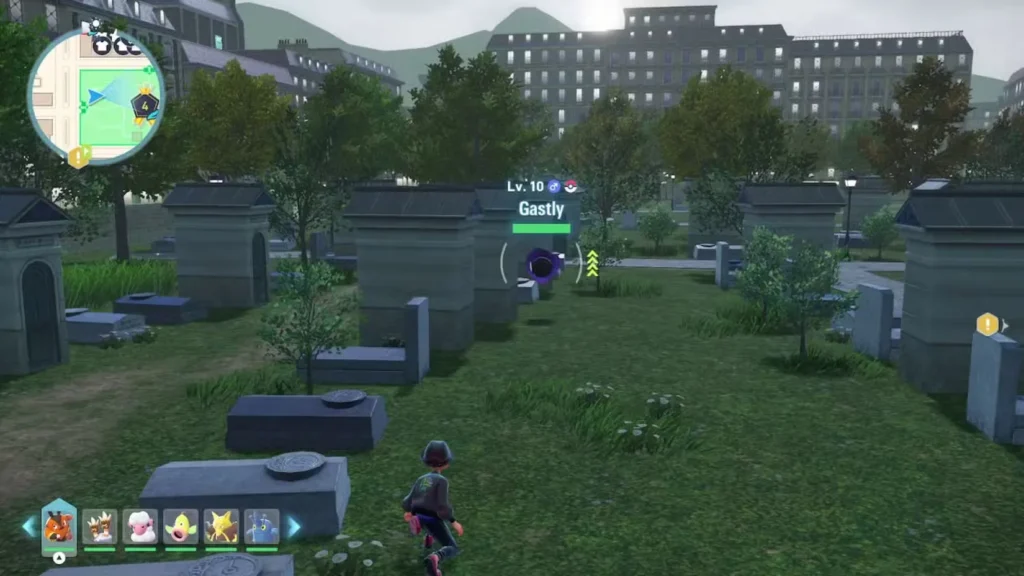
Where to find it: Literally everywhere. Gastly roams freely between tombstones throughout the entire cemetery.
Spawn frequency: This is the most common Pokemon in Wild Zone 4. You’ll trip over multiple Gastly during any visit.
Time requirement: Available during both day and night.
Why catch it: Beyond Pokedex completion, Gastly evolves into Haunter at level 25, then Haunter can be traded to evolve into Gengar (one of the most iconic Ghost-types in Pokemon history). If you’re building a Ghost-type team or need Ghost coverage, this is your starter.
Catching strategy: Gastly is Ghost/Poison, so it’s weak to Ground, Psychic, Ghost, and Dark-type moves. It’s not particularly aggressive or difficult to catch—just standard engagement works fine.
Fun fact: The cemetery setting for Gastly spawns is thematically perfect. This is exactly where you’d expect to find Ghost-types in any Pokemon game.
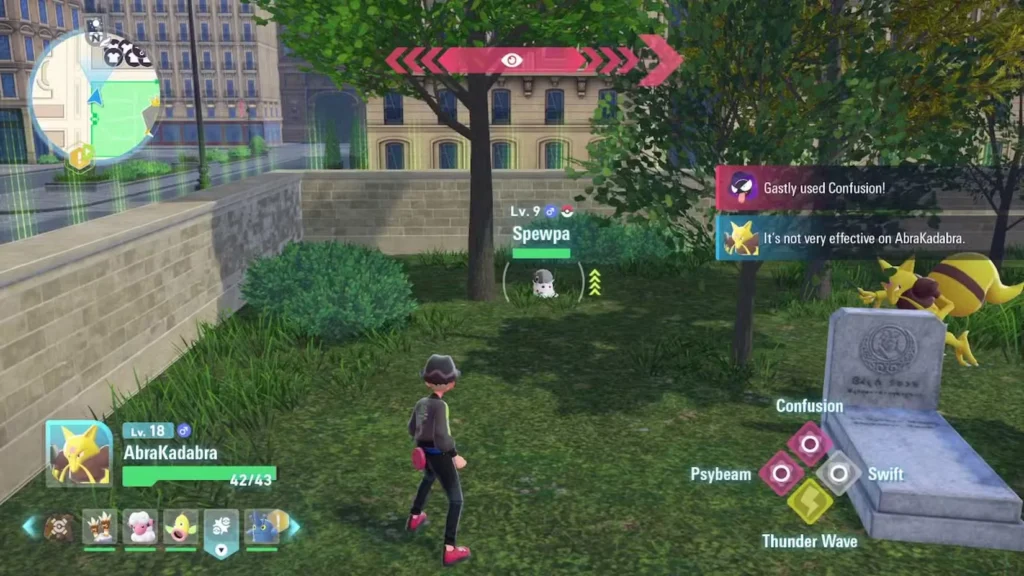
Where to find it: Immediately to the left of the Wild Zone 4 entrance, hiding in bushes.
Behavior warning: Spewpa is timid and will flee if you give it the chance. Don’t approach slowly or it’ll run before you can engage.
Catching strategy: Use your best Fire or Flying-type move to take it out in one hit. This isn’t about being cruel—fainting it in one shot dramatically increases capture rates.
Why this matters: Bug-types often have low Defense stats, and Spewpa is no exception. One-shot tactics work better than trying to whittle down its HP gradually, which gives it more chances to flee.
Evolution path: Spewpa evolves into Vivillon, a Bug/Flying-type with decent competitive viability and beautiful wing patterns. Worth catching if you’re a collector.
Important note: If you accidentally faint any Wild Zone Pokemon (including Spewpa), they respawn when you exit and re-enter the area. Don’t stress if you knock one out—just leave and come back.
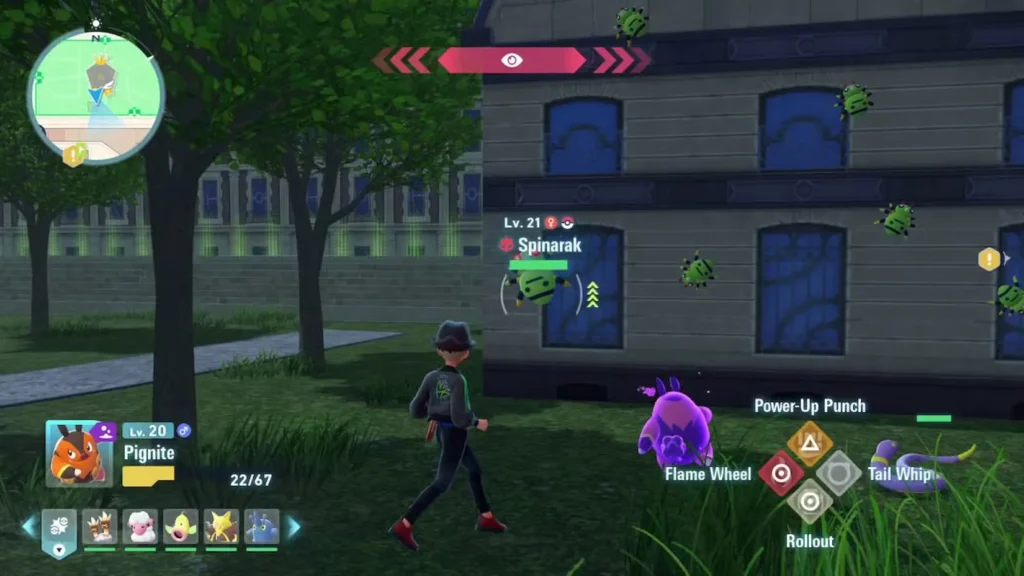
Where to find it: Clinging to tombstone walls throughout Wild Zone 4. The central mausoleum has nearly a dozen Spinarak on its walls.
Visual tip: Look at vertical surfaces, not just the ground. Spinarak literally sticks to tombstones and structures like a real spider would.
Best hunting spot: The mausoleum in the middle of the cemetery is Spinarak central. If you’re having trouble finding them elsewhere, go straight to this structure.
Time requirement: Available during both day and night.
Strategic value: Spinarak evolves into Ariados, a Bug/Poison-type. While not the strongest Pokemon competitively, Ariados has access to some useful moves and the dual typing gives it interesting coverage options.
Catching strategy: Standard engagement works. Spinarak isn’t particularly difficult or aggressive—just walk up and throw a Poke Ball or initiate combat.
Pro tip: If you’re systematically completing Wild Zones and need Bug-type entries, Spinarak is one of the easier catches in the game. Take advantage of its abundance here.
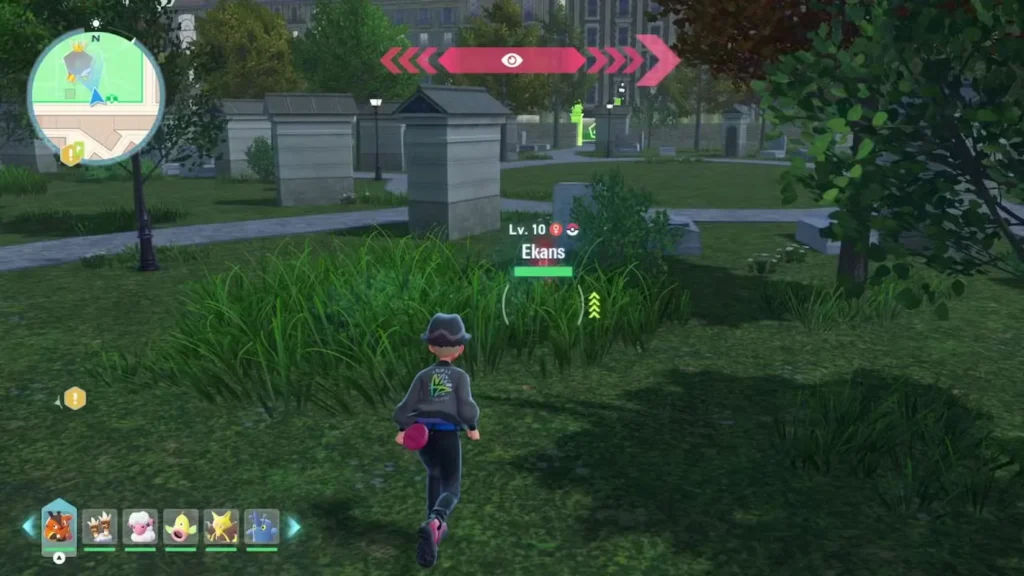
Where to find it: Hiding in tall grass patches throughout Wild Zone 4.
Why it’s tricky: Ekans blends into tall grass extremely well. You can walk right past one without noticing.
The solution: Press ZL near grassy areas to automatically lock onto Pokemon. When you get close enough to an Ekans, your lock-on will engage, revealing its position even if you can’t see it visually.
Behavior warning: Ekans is aggressive. If it notices you, it will initiate combat immediately. Be ready for a fight when hunting in grass patches.
Combat approach: Ekans is pure Poison-type, so it’s weak to Ground and Psychic moves. If you’ve been following early-game catching advice, you probably have something that can handle it easily.
Evolution path: Ekans evolves into Arbok at level 22, gaining better stats while maintaining pure Poison typing. Arbok has decent Attack and can learn intimidating moves like Glare (paralysis) and Crunch.
Strategic tip: If you’re building a team focused on status effects (Poison, Paralysis), catching Ekans early gives you a solid foundation for that playstyle.
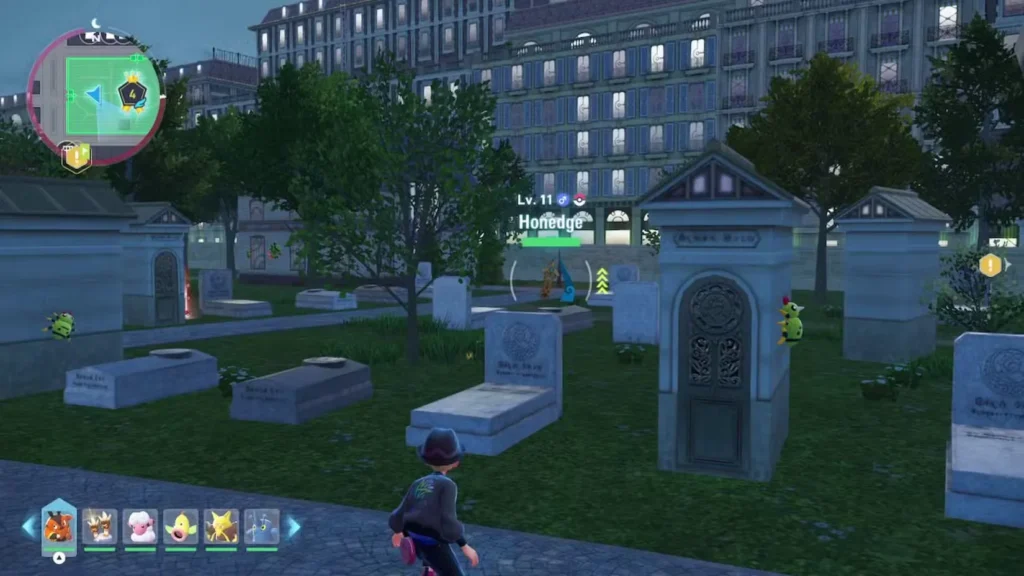
Where to find it: Floating along the main pathway at night. Multiple spawn points exist throughout the cemetery’s central route.
Time requirement: Night only. You will not find Honedge during the day, period.
Why it’s special: Honedge is a Steel/Ghost-type, which is an incredible defensive typing. It resists 10 different types and is immune to Normal, Fighting, and Poison. This makes Honedge one of the best defensive Pokemon you can catch in early Wild Zones.
Evolution path: Honedge → Doublade (level 35) → Aegislash (Dusk Stone). Aegislash is a competitive powerhouse with a unique ability that changes its stats between offensive and defensive forms. If you’re planning long-term team building, catching Honedge is a high-priority move.
How to change time to night: You’ll need to unlock the time-changing mechanic first, which requires completing Main Mission 5 and finishing three side quests for Emma.
Once unlocked:
For full details on the time-changing system, check our complete guide on changing day to night.
Catching strategy: Honedge isn’t particularly aggressive but it’s worth the effort. Use Dusk Balls if you have them (increased catch rate at night), or weaken it with Fire or Ground-type moves before throwing Poke Balls.
Pro tip: If you’re specifically hunting for Alpha Pokemon, keep an eye out for an Alpha Honedge. The stat boost makes it even more valuable.
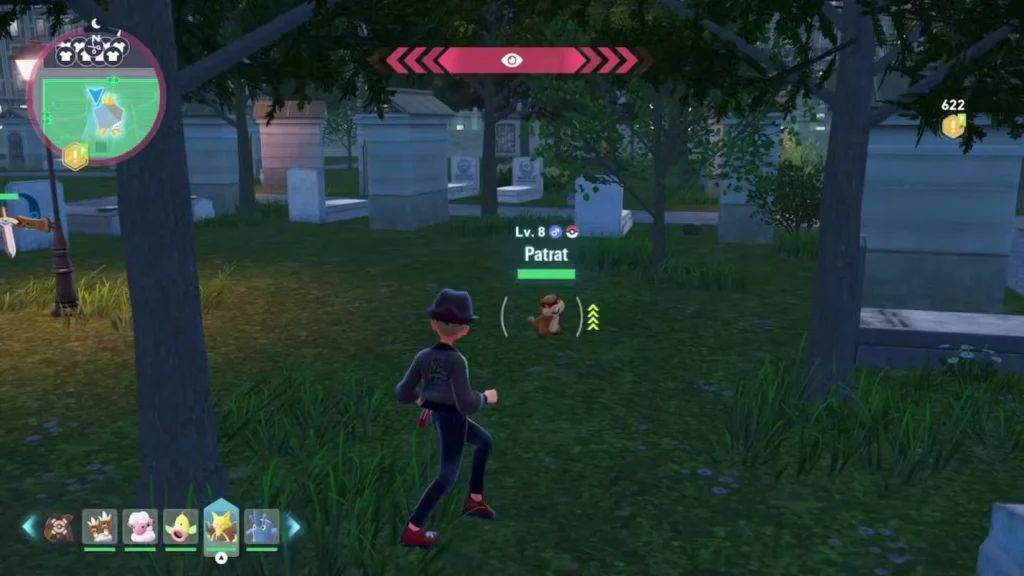
Where to find it: Appears at night in Wild Zone 4, though specific spawn points vary.
Time requirement: Night only.
The important exception: If you already caught Patrat in Wild Zone 2, it automatically counts for Wild Zone 4 completion. You don’t need to catch another one.
Why this matters: This is a huge time-saver. Many players waste effort recatching Patrat in Wild Zone 4 when they already have full credit from Zone 2. Check your Pokedex before hunting unnecessarily.
If you didn’t catch it in Zone 2: You’ll need to visit Wild Zone 4 at night to find and catch Patrat. It’s a Normal-type with straightforward catching requirements—no special strategy needed.
Strategic value: Patrat evolves into Watchog, which is… fine. It’s not particularly strong or weak, just a solid Normal-type with decent stats. If you’re completing the Pokedex, catch it. If you’re min-maxing your team, there are better options.
Since two Pokemon are night-exclusive, here’s the optimal approach:
Catch in this order:
This gets you 4 out of 6 Pokemon in a single daytime visit.
Once you’ve unlocked time-changing:
This completes 100% Wild Zone 4 in two efficient visits.
Some players try to complete zones in one visit, wandering around hoping everything spawns. This doesn’t work when Pokemon have time requirements. Two focused visits (day + night) is faster and more efficient than multiple random attempts.
Here’s a mechanic that alleviates anxiety: Wild Zone Pokemon respawn when you exit and re-enter the area.
What this means:
How to trigger respawn:
Why this is important: You can’t permanently miss Pokemon by defeating them. This removes pressure and lets you experiment with catching strategies without worrying about ruining completion.
Which Pokemon from Wild Zone 4 are actually worth adding to your team?
Why it’s excellent:
Recommendation: Definitely catch and consider for main team.
Why it’s good:
Recommendation: Catch for Pokedex, consider for team if you need Ghost coverage.
Why they’re okay but not amazing:
Recommendation: Catch for completion, but don’t feel obligated to use them in your main six.
Why it’s situational:
Recommendation: Catch if you didn’t already get it in Zone 2, otherwise skip unless you specifically want Watchog.
Wild Zone 4’s Pokemon interact with other zones you’ve explored:
Wild Zone 2 connection: If you caught Patrat there, you have automatic credit here. This is the only Pokemon that cross-registers between zones currently identified.
Type coverage: Wild Zone 4 offers Ghost and Poison-type Pokemon that complement what you found in Wild Zone 2 (Water, Bug, Grass types).
Progression flow: By the time you reach Wild Zone 4, you should have a solid core team from earlier zones. Pokemon caught here are supplements and Pokedex entries rather than mandatory team members (except Honedge—seriously, catch Honedge).
“I can’t find Honedge anywhere!”
You’re visiting during the day. Honedge only spawns at night. Change time to night and return.
“Spewpa keeps running away before I can catch it!”
Don’t approach slowly. Use a Fire or Flying-type move to one-shot it immediately upon engagement. This maximizes catch rate and prevents fleeing.
“Where are all the Spinarak?”
Look at vertical surfaces, especially the central mausoleum walls. Spinarak cling to tombstones, not the ground.
“I can’t see Ekans in the grass!”
Use ZL to lock on near grassy areas. The auto-lock reveals hidden Pokemon even if they’re visually camouflaged.
“Do I need to catch Patrat again?”
Check your Pokedex. If you caught Patrat in Wild Zone 2, it already counts for Zone 4 completion.
While hunting Pokemon in Wild Zone 4, keep an eye out for:
Gold sparkles: These contain treasure items like Tiny Mushrooms that sell for money, funding your evolution stone purchases and Poke Ball restocks.
Crafting materials: Wild Zones spawn materials like Colorful Screws and Clear Purple Sludge needed for better equipment.
Alpha Pokemon: Occasionally, Alpha variants spawn with better stats. If you encounter an Alpha Honedge or Alpha Gastly, prioritize catching them.
Pro tip: Combining Pokemon catching with resource gathering makes Wild Zone visits more efficient. Don’t just tunnel vision on Pokemon—grab everything useful you see.
Once you’ve completed Wild Zone 4, you’re building momentum toward full Pokedex completion:
Continue exploring: Future Wild Zones have their own unique Pokemon and challenges
Evolve your catches: Work on evolving Pokemon like Gastly and Honedge that require leveling or special items
Consider happiness evolutions: Some Pokemon need high friendship to evolve. Check our happiness increase guide for strategies.
Plan for Eevee: If you haven’t caught Eevee yet, familiarize yourself with all Eeveelution options for future team planning.
Team optimization: Evaluate whether any Wild Zone 4 catches improve your current roster. Honedge’s defensive typing might fill a gap you didn’t know you had.
Wild Zone 4 stands out for its cemetery atmosphere and Ghost-type focus. It’s thematically consistent—you’re exploring a graveyard, so of course Gastly and Honedge call it home. The nighttime requirement for Honedge adds a layer of challenge that rewards players who understand the time-changing mechanics.
Key takeaways:
The cemetery setting might be spooky, but with this guide, completing Wild Zone 4 is straightforward. Now get out there and catch those Ghost-types!
For official Pokemon Legends Z-A information, visit the Pokemon Legends website or purchase the game from the Nintendo Store.
Also Read: